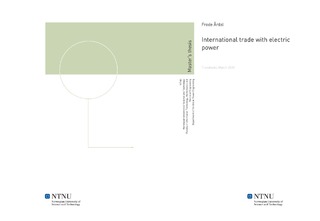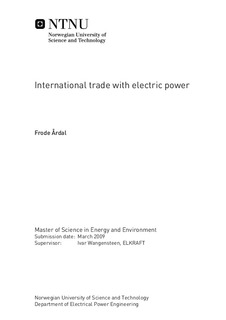| dc.contributor.advisor | Wangensteen, Ivar | nb_NO |
| dc.contributor.author | Årdal, Frode | nb_NO |
| dc.date.accessioned | 2014-12-19T13:51:15Z | |
| dc.date.available | 2014-12-19T13:51:15Z | |
| dc.date.created | 2010-09-04 | nb_NO |
| dc.date.issued | 2009 | nb_NO |
| dc.identifier | 348740 | nb_NO |
| dc.identifier | ntnudaim:4441 | nb_NO |
| dc.identifier.uri | http://hdl.handle.net/11250/256609 | |
| dc.description.abstract | In 2003 the European Commission introduced the Directive 2003/54/EC and Regulation 1228/2003/EC which increased the focus on the liberalization of the European electricity market. The international electricity trade has increased and created new challenges related to cross-border transmission and compensation mechanisms. The focus of the report has been to discuss the development of the electricity market in Europe, and the status of international exchange. The report also discusses the concept of cross-border trade and transit, and investigates a proposed ITC model and whether correct investment incentives are given. Price data from the main power exchanges in Europe indicate that the market is experiencing increasingly integration and efficiency. There has also been a trend towards market based congestion management methods. Regional markets have successfully developed in Spain and Portugal (the Iberian market) and between France, Belgium and The Netherlands (the Trilateral Market Coupling, TLC). Further plans for regional coupling are also underway (see chapter 5. The most common definition of transit is the one adopted by ETSO (Association of European Transmission System Operators), where transit is defined as the minimum between exports and imports. This definition could create opportunities for market participants to manipulate transit income (discussed in chapter 5.3). The Inter-TSO compensation (ITC) model used in this report is based on the With-and-Without transit algorithm. The model only focuses on costs and load flow, and do not include market incentives or evaluation of benefits. The model bases the compensation calculation on the transit term, which can lead to misguided identification of network responsibility. Two scenarios were compared with a base case scenario in order to identify possible investment incentives. The first scenario included a situation where one of the cross-border lines in the network was constrained. Results from this simulation indicate that the transmission system operators involved would experience increased ITC payment, and therefore not receive investment incentives. The TSOs involved would benefit from the bottleneck in form of increased revenue (assuming Cost-Of-Service regulation). In the second scenario an extra cross-border line was implemented, and the situation was compared to the base case. The results from this simulation show that the TSOs involved would receive a positive effect in form of reduced ITC cost. The ITC mechanism would in this case be in line with the European Commission’s Regulation 1228/2003/EC, and give the involved TSOs correct investment incentives. The lack of correlated results in these two cases indicates that the ITC mechanism (in this case modeled by the WWT algorithm) cannot be regarded as relevant from an investment incentive perspective (more information found in chapter 7.3). | nb_NO |
| dc.language | eng | nb_NO |
| dc.publisher | Institutt for elkraftteknikk | nb_NO |
| dc.subject | ntnudaim | no_NO |
| dc.subject | SIE5 energi og miljø | no_NO |
| dc.subject | Energibruk og energiplanlegging | no_NO |
| dc.title | International trade with electric power | nb_NO |
| dc.type | Master thesis | nb_NO |
| dc.source.pagenumber | 71 | nb_NO |
| dc.contributor.department | Norges teknisk-naturvitenskapelige universitet, Fakultet for informasjonsteknologi, matematikk og elektroteknikk, Institutt for elkraftteknikk | nb_NO |

